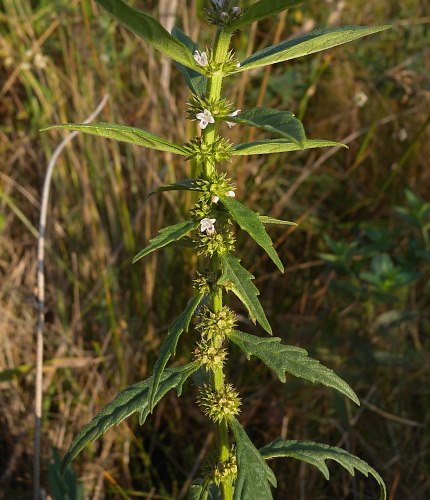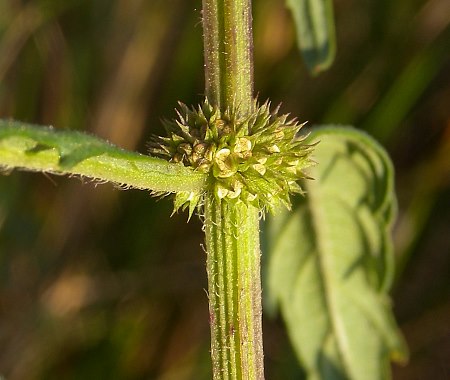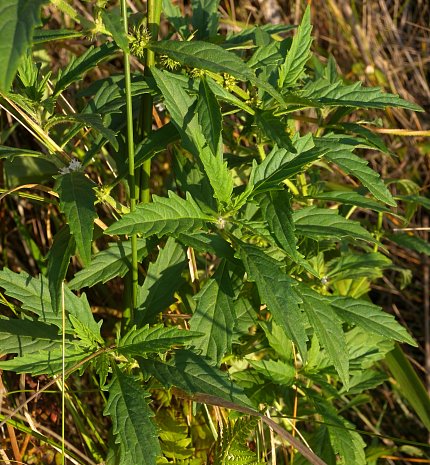
Dense sessile whorls of small flowers occur in the axils of the upper leaves. Individual flowers are 1/8" (3 mm.) across, consisting of a short-tubular calyx with 4-5 teeth, a white corolla with 4 lobes, 2 fertile stamens, and an ovary with a style that is bifurcated at its tip. The calyx is light green or yellowish green and glabrous to sparsely pubescent; its teeth are linear-lanceolate (more than 2 times longer than across), tapering gradually to awn-like tips. Generally, the teeth of the calyx are longer than its tube. The lowest corolla lobe of each flower is purple-spotted. Linear-lanceolate bractlets are present at the bases of the flowers. The blooming period occurs from mid-summer to autumn, lasting 2-3 months. Only a few flowers are in bloom at the same time toward the apex of the plant. Each flower is replaced by 4 nutlets that together form a slightly concave surface within the persistent calyx; these nutlets are shorter than the calyx. Individual nutlets are about 1.5 mm. long, obovoid, and angular along their sides. The root system is highly rhizomatous, forming colonies of plants from clonal offsets.
Cultivation: The preference is full or partial sun, wet to moist conditions, and soil that is loamy, silty, or sandy.

Range & Habitat: The non-native Gypsywort is rare in Illinois, where it has been collected in McHenry County in the northeast section of the state (see Distribution Map). However, it is likely that this wildflower has occurred elsewhere within the state, at least temporarily. Gypsywort was introduced into the United States from Europe. Its current distribution is concentrated along the Atlantic coast and Great Lakes, where it may have been introduced accidentally from the release of ballast by ocean-going cargo ships. Habitats in Illinois and other states in the Great Lakes region include wet sand prairies, interdunal swales and sloughs, riverbanks and edges of ponds, fens, marshy areas, and ditches. Usually Gypsywort is found in more disturbed areas, although it also occurs in higher quality wetlands, where it has some potential to be invasive.
Faunal Associations: For a closely related species, Lycopus americanus (Common Bugleweed), Robertson (1929) observed long-tongued bees, small-tongued bees, wasps, and flies as visitors of the flowers, where they fed primarily on nectar. In Germany, Müller (1873/1883) observed mostly Vespid wasps and miscellaneous flies visiting the flowers of Gypsywort. These insects cross-pollinate the flowers. The leaves of Lycopus spp. are eaten by the caterpillars of Sphinx eremitus (Hermit Sphinx). Mammalian herbivores generally avoid consumption of the foliage of species in this genus because of its bitter taste and lack of palatability.

Photographic Location: A wet sand prairie at the Indiana Dunes National Lakeshore in NW Indiana.
Comments: Gypsywort is the only species of this genus that has been introduced from Europe into Illinois. It is very similar in appearance to the several native species (Lycopus spp.) that occur within the state (primarily in northern Illinois). Gypsywort differs from these native species by one or more of the following characteristics: 1) throughout the length of each plant, its leaves are more coarsely dentate or pinnatifid, 2) the corolla of its flowers has only 4 lobes, 3) the teeth of its calyx are longer than the tube of its calyx and they are at least twice as long as they are across with awn-like tips, 4) each group of 4 nutlets within its calyx form a slightly concave surface, rather than a truncate or bumpy surface, and 5) its stems and leaf undersides tend to have longer hairs than some native species in this genus. Another distinctive characteristic of Gypsywort consists of the glandular depressions along the upper surface of its leaves, but this may require a 10x hand lens to see. In addition to Gypsywort, other common names of Lycopus europaeus are Marsh Horehound, European Water Horehound, and European Bugleweed.